Your expert guide: awesome things to do in Segovia

Whether you have a day in Segovia or you’re able to carve out a few extra days for this magnificent city, there are plenty of excellent things to do, see, experience and even eat. In this article we’ll work through all the sites you can’t miss as well as help you figure out where to stay and how long you need in Segovia.
So let’s figure out how to best enjoy your time in Segovia!

There are affiliate links in this article. If you click and make a purchase I could make a small sum at zero cost to you. Thank you!
How long do you need in Segovia?
⏱ Most people visit Segovia for the day when they’re in Madrid (I love Madrid, by the way) but I truly believe Segovia is worth more than a quick day trip if you can manage it.
I was lucky and spent 3 days in Segovia, but with only a day, you can definitely get the highlights since this gorgeous town is so small.
How do you get to Segovia?
Segovia is located in the autonomous region of Castilla y León pretty much right in the middle of the Iberian Peninsula.
🚂 Segovia’s local train station is located on Calle Obispo Quesada s/n, about a 20-minute walk from the historic centre. High-speed trains arrive at the AVE station, about 6 kilometres from the city centre. It takes 1 hour on the AVANT train or 30 minutes on the AVE, the high-speed train to get to Segovia from Madrid.
→ Check train times and prices now on Trainline
🚌 Segovia’s bus station is located on Paseo Ezequiel González, a ten-minute walk from the Plaza Mayor.
→ Check bus times and prices now on Omio
🚗 If you’re driving then it’s worth knowing that there is plenty of parking outside the old town. Taxis can be picked up on the Plaza Mayor. After driving in ourselves, I don’t recommend trying to take your car into the old town.
→ Check car rental options and prices now
👣 There are plenty of excellent tours agencies offering day trips to Segovia. These are 2 of my favourites: 🎈 Hot Air Balloon Ride over Segovia 🚌 Full-Day Tour of Segovia and Avila – two of Spain’s oldest cities
Where to stay in Segovia
🏨 MexicoCassie luxury recommendation: Áurea Convento Capuchinos – for me, this 5⭐️ central hotel is the most beautiful hotel in Segovia. Located in a former monastery that has been lovingly refurbished, and offers big rooms with extremely comfortable beds. There is a spa on-site, parking and breakfast is excellent here.
🏨 MexicoCassie value for money recommendation: Exe Casa de los linajes – this hotel is in a gorgeous refurbished 16th century building that has maintained many original features so you can really feel the history of the city when you stay here. Choose a room with a terrace or enjoy the roof terrace for great views over the city
🏨 MexicoCassie stay in a palace recommendation: Hotel Cetina Palacio Ayala Berganza – another refurbished building, this time a 15th century palace that offers luxurious rooms with original features. The hotel has a delightful courtyard, and offers an excellent breakfast.
If these don’t fit your needs, why not use my helpful, interactive accommodation finder map to find something more suited to your needs.
What do I need to know about Segovia?
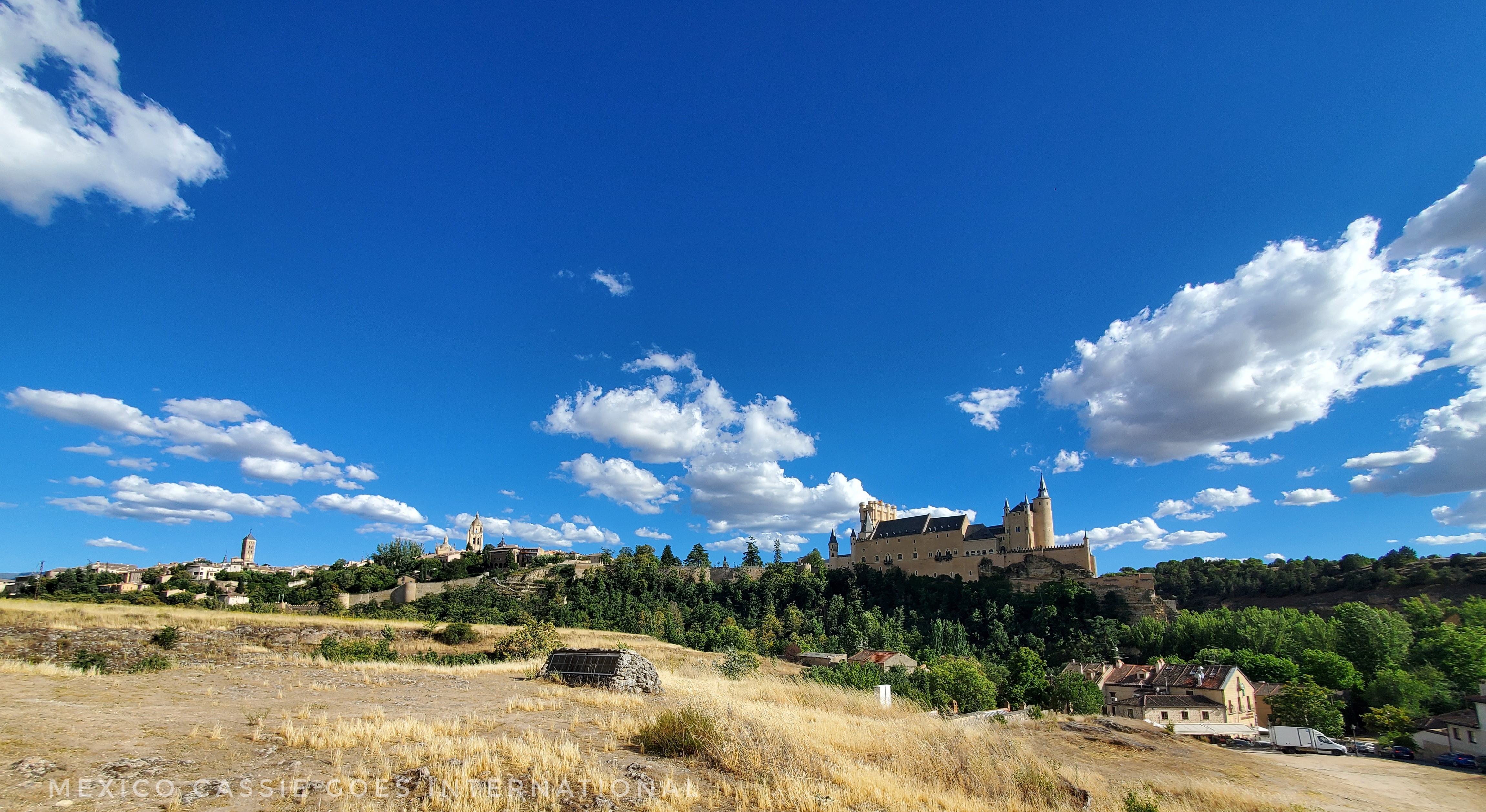
⭐️ Segovia is such a special place that in 1985, the whole city centre was declared a UNESCO World Heritage city.
⭐️ Segovia is particularly famous for its gorgeous castle (Alcazar de Segovia) and the Roman aqueduct that merrily winds its way along the edge of town.
⭐️ The old town of Segovia (where everything you want to see is located) is crowded on top of a rocky bluff delineated by the Rivers Eresma and Clamores.
👀 While wandering around Segovia, I found it particularly fascinating to note how beautifully the buildings are decorated. I’m sure most of it is modern but it beautifully imitates what the city must have looked in the Middle Ages.
A very brief history of Segovia
📌 There have been settlements on the site of modern-day Segovia since the Celts lived in this region. In fact, some people think that the name Segovia comes from the Celtic word for “fortress”. As happened across much of the Iberian Peninsula, the Visigoths took control of Segovia when the power of the Roman Empire on the peninsula waned. They then lost control to the Moors who were eventually driven out by the Catholic King Alfonso VI of Léon y Castilla in 1088.
In 1475 the Concord of Segovia was signed between Queen Isabella of Castilla and Ferdinand of Aragon – a seminal moment on the path toward the unification of Spain. During the Middle Ages, the city flourished thanks to its advantageous geographic location but declined later to a population of just 8,000. It was economic stability during the late nineteenth and early twentieth century that once again allowed Segovia to flourish.
What to do in Segovia
Obviously the amount of time you have in Segovia will dictate what you can do & see. This article puts the big name, ‘don’t miss’ items first.
If city tours are your thing, try one of these fun options.
👣 Take a free walking tour of Segovia to get your bearings and learn about the history of the city.
🚌 Take the hop-on-hop-off bus tour of Segovia
🚲 Book a 3-hr e-bike tour of the city
📲 Download a self-guided tour and Segovia scavenger hunt
Alcázar de Segovia
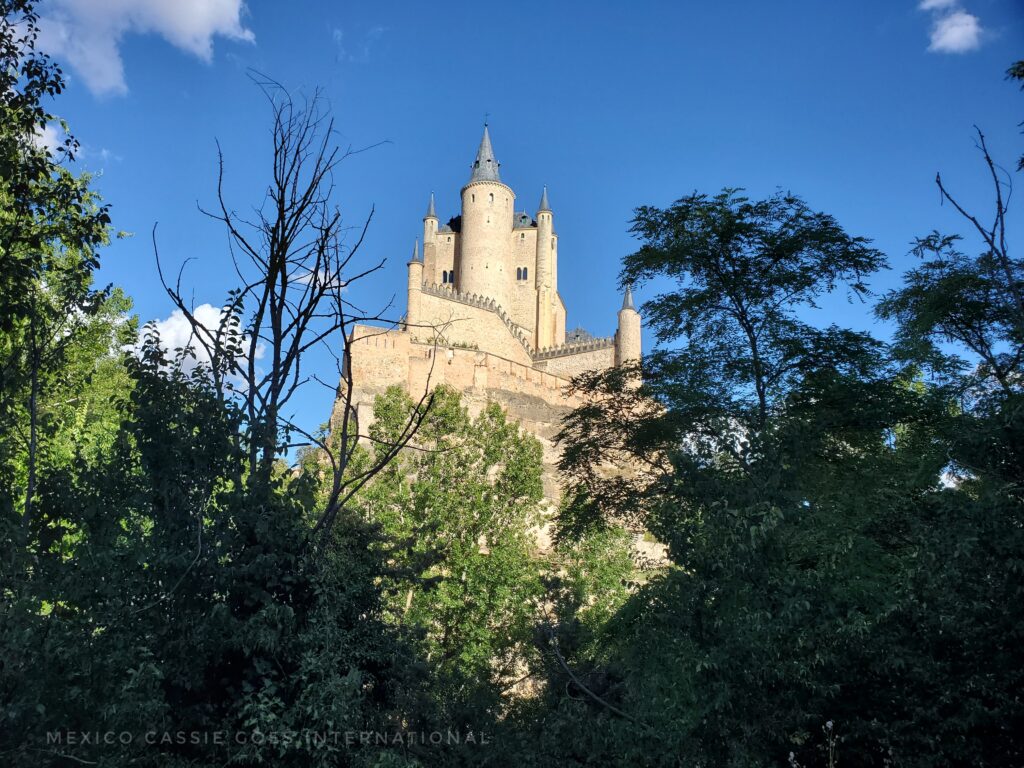
🏰 One of the most visited sites in Spain, the Alcazar of Segovia is a magnificent building that served as an inspiration to Walt Disney when he created the Cinderella Castle. Wouldn’t it be incredible if more people knew that the origins of this fairytale castle lay in a Berber Almoravid fortification from an extremely complex time in Iberian history? The castle is first mentioned in 12th-century texts and over the centuries has been a fortress, a royal residence, a state prison, the Royal Artillery College and a military academy. Today it is a museum and also home to military archives.
The famous tower, el Torre del Homenaje (Homage Tower) was where the Crown of Castille stored their wealth – money was taken from here to finance Christopher Columbus’ first voyage across the Atlantic.
The Alcázar is where the Catholic monarchs signed the ‘Agreement for the Government of the Kingdom’ (also known as the ‘Concord of Segovia), which established the distribution of the responsibilities of government between Ferdinand (of Aragon) and Isabella (of Castille) in their respective territories. This took place in January 1475 and is considered to have been a milestone on the road toward the unity of Spain.
👀 While you’re exploring the castle, do take a moment to pause in the Sala de los Reyes (Hall of Kings/ Throne Room) because, quite honestly, I’ve never seen anywhere like it. I was wowed by the ceiling carvings.
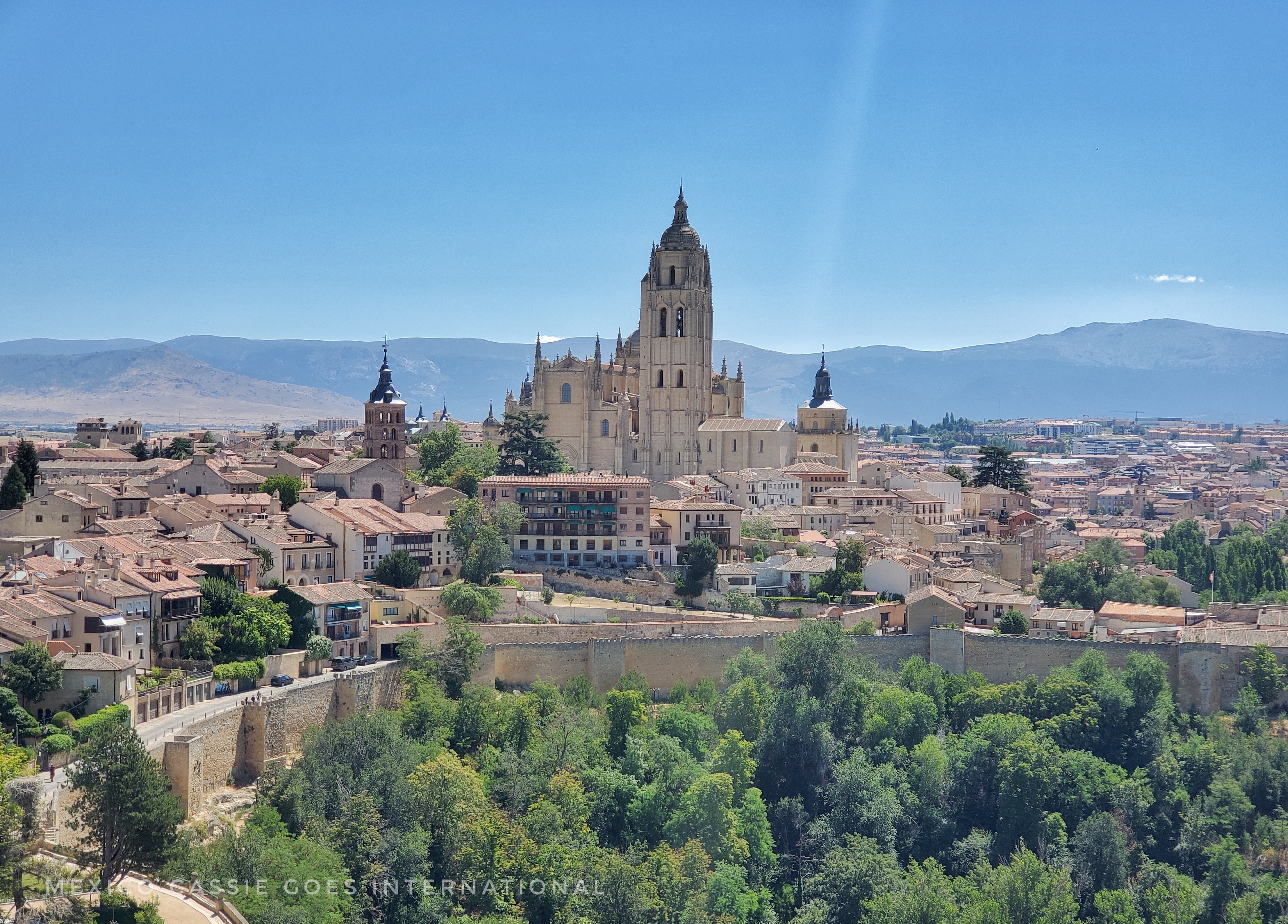
Top Tips for Visiting The Alcazar de Segovia
✅ Book your entrance ticket to the Alcázar online in advance as a set number of people are permitted per hour. You don’t want to miss the chance to visit this gorgeous building.
✅ Be sure to head up onto the roof for the incredible views over Segovia (photo above).
✅ The cafe here sells excellent bite-size pieces of cochinillo, roast suckling pig, the local delicacy at very reasonable prices. If you don’t want to break the bank and order a pricy full-size plate then this is a great alternative (and in my opinion, tastier too).
⏱If you enjoy military museums, leave two hours for everything. If, like me, you’re not super into military stuff, ninety minutes will be fine.
Where to find the best views of the Alcazar
As you approach the Alcazar you’re going to be wowed by this striking, fairytale palace. There are some spots in town that offer amazing views of it.
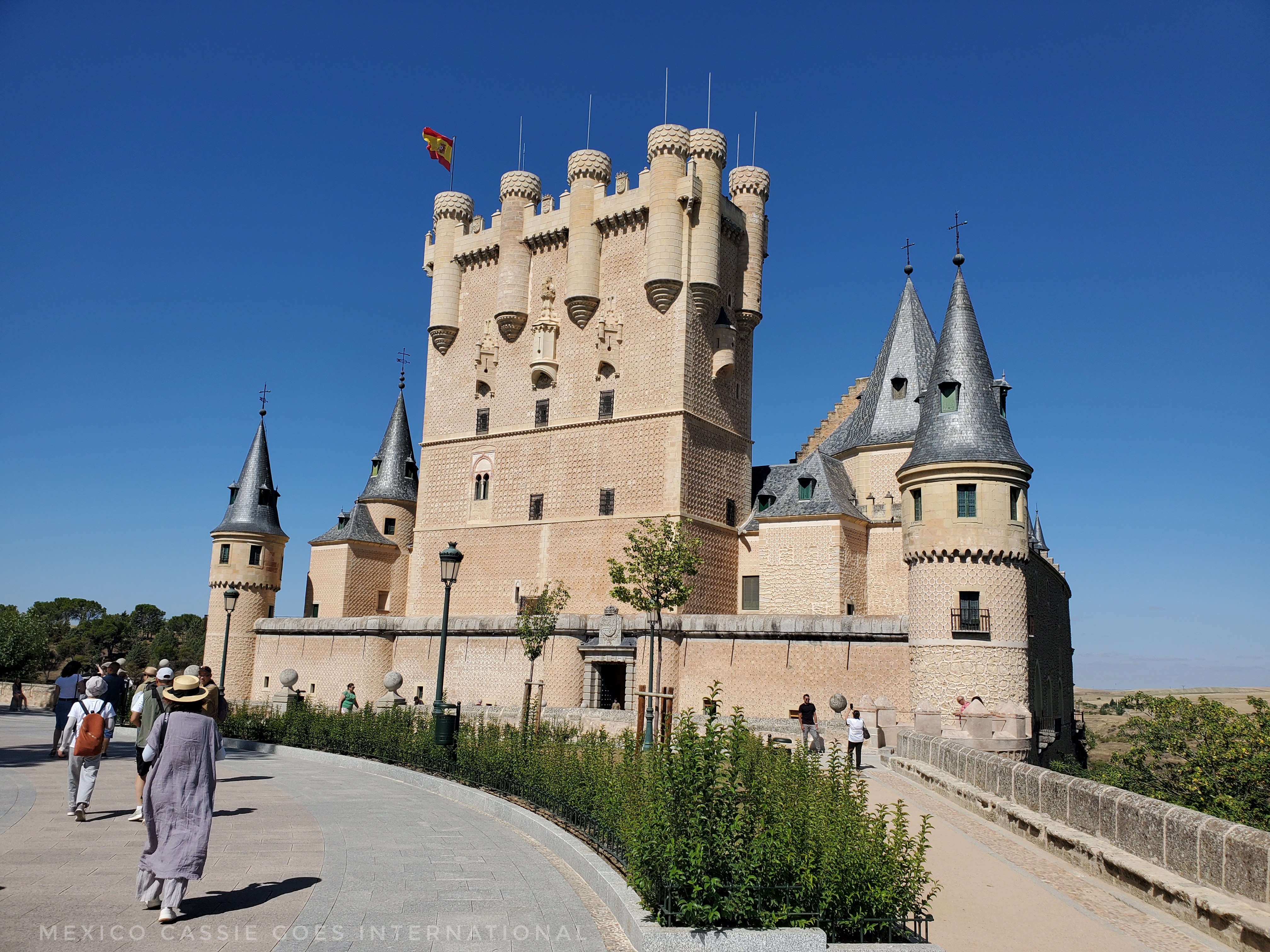
📌 If you have time head to the gardens below the palace (find steps down by the Cueva de la Zorra for incredible views of the castle in all its glory (view earlier photo).
📌 Walking along the Rda de Don Juan II (from the Puerta de San Andrés) you’ll be walking along the old city walls with the Alcazar in front of you.
📌 Below the castle and the city walls are allotments, and park paths, enjoy strolling through this delightful green area and oogling the castle as you do.
📌 Mirador del Último Pino – we didn’t make it up here because we’d already tried so many other excellent viewpoints but had we had an extra hour or so I’d have stomped on up here for sure.
Roman Aqueduct of Segovia
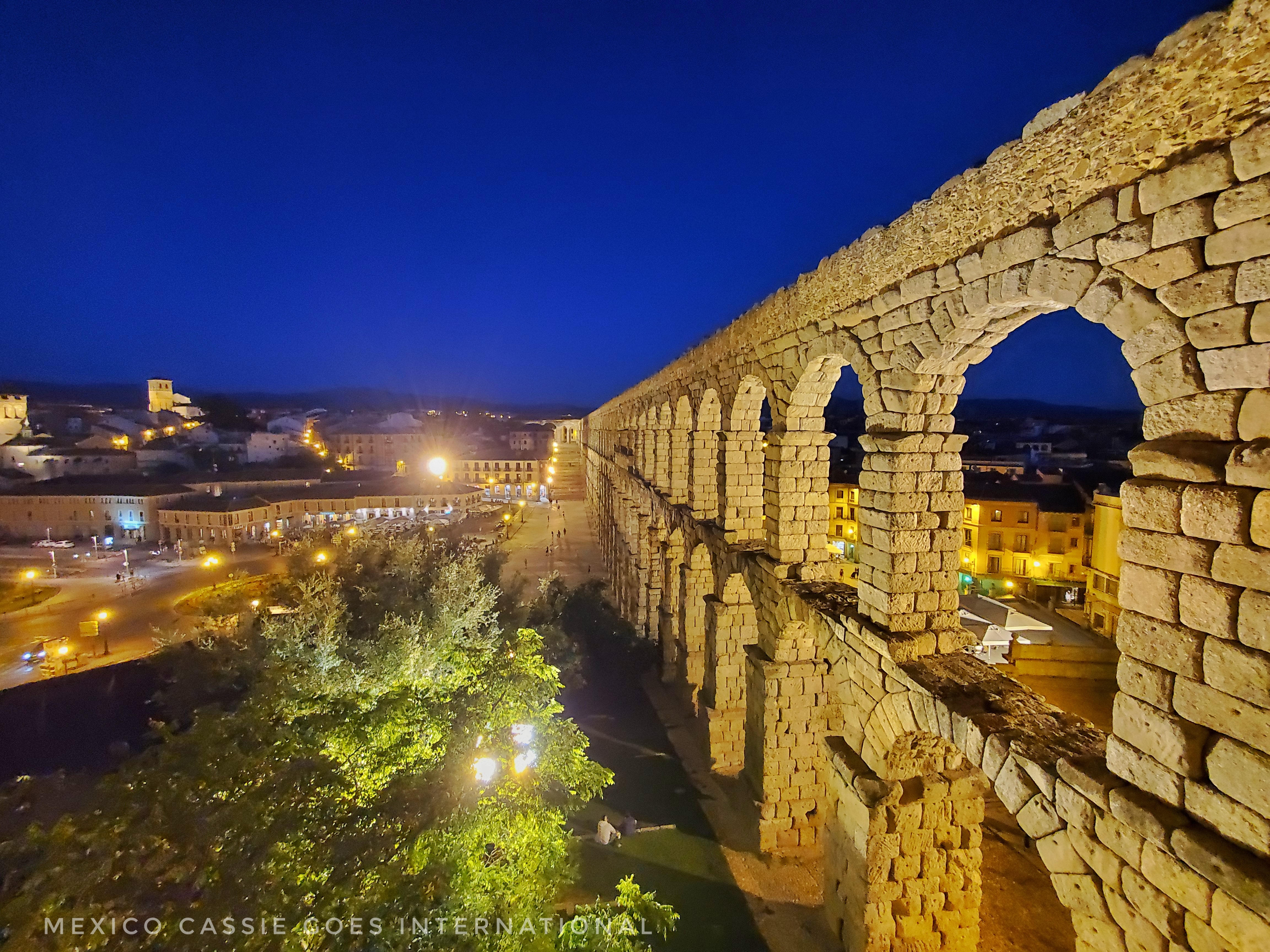
📌 This striking and famous ancient Roman aqueduct was built sometime around the first century AD to move water from the mountains to the city. The aqueduct remained intact under Visigoth and Moorish rule until 1072 when thirty-six arches were destroyed in the war between the Moors and the Catholics. This section was eventually restored at the end of the fifteenth century.
📌 Incredibly, the aqueduct was used to transport water into the city until 1973. This is one of the best-preserved Roman aqueducts in the world and is a site not to be missed if you have a day in Segovia.
📌 Water was transported from the Río Frio some 15km from Segovia. What we can see today is just a small section of the aqueduct. Much of the aqueduct was underground but due to the location of Segovia on a bluff, a valley had to be crossed to get water to the city, hence the bridge formation. Once in Segovia, the aqueduct disappears underground again.
📌 At its tallest, the aqueduct is almost 30 m high. The more striking section of the aqueduct is double arched while around the corner it becomes single arches. In total, there are 167 arches. The aqueduct is made from beautifully shaped granite blocks that are held together without mortar. Incredible!
Where to get the best views of the Aqueduct
Postigo del Consuelo
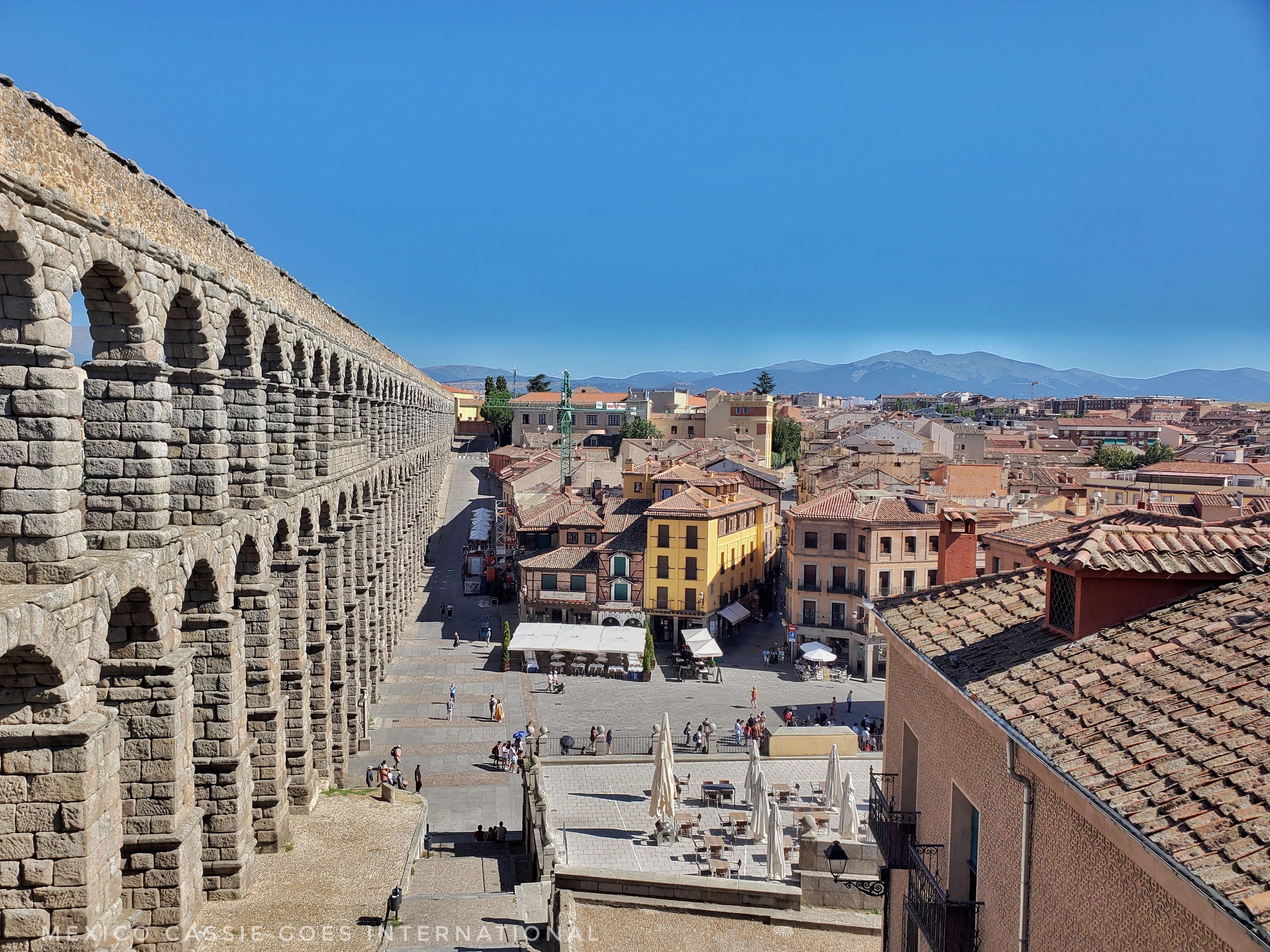
📌 The aqueduct meets the city walls on the Plaza del Azoguejo. Climb the steps beside the Tourist Information for magical views of the aqueduct’s arches and the surrounding areas from the Postigo del Consuelo.
📌 Head up to the Statue of the Devil on Calle San Juan for fun views and selfies with the modern devil sculpture (an origin myth of the aqueduct is that a servant girl fed up with fetching water every morning made a deal with the devil).
📌 Follow the aqueduct up and around the corner onto Calle Almira for views as it shrinks to one row of arches on its way out of town.
📌 You can also find maps showing the route of the aqueduct through the city as it heads underground. There is an Aqueduct Interpretion Centre in the Museo Real de Moneda.
What else to see in Segovia
The Aqueduct and the Alcazar are the two major attractions in Segovia and they are located at opposite ends of the Old City of Segovia so as you explore the narrow streets and down below, check out:
Museo Real de Moneda de Segovia

This museum of coins and industrial heritage is actually not in the Old City of Segovia but is located down below across the road from the park. If you plan on heading down for excellent views of the ancient royal palace then this museum is worth a moment of your time.
We didn’t go into the museum itself because the kids were exhausted but we did pop our heads around the back to check out the incredible water wheels at this former royal mint.
The Old Jewish Quarter
There’s really very little that’s Jewish left to see in Segovia since the Jews were expelled in 1492. As you stroll through the narrow streets of Segovia keep an eye out for small plaques on the walls.
The Jewish history of Segovia begins in the 13th century but in 1480 the Jewish population was confined to the Jewish quarter in the south of the city. There were five synagogues in Segovia although only the primary one is preserved – today it is the Corpus Christi Convent.
Centro Didactico de la Judería
This small museum offers a short history of the Jewish community in Segovia. If you’re short on time then I recommend holding off and going to the Jewish museums in Cordoba, which are, in my opinion more informative and more interesting.
Segovia Museum
This museum is small but has a good array of historical pieces documenting life in Segovia through the ages.
Around the Plaza Mayor and the Catedral de Segovia
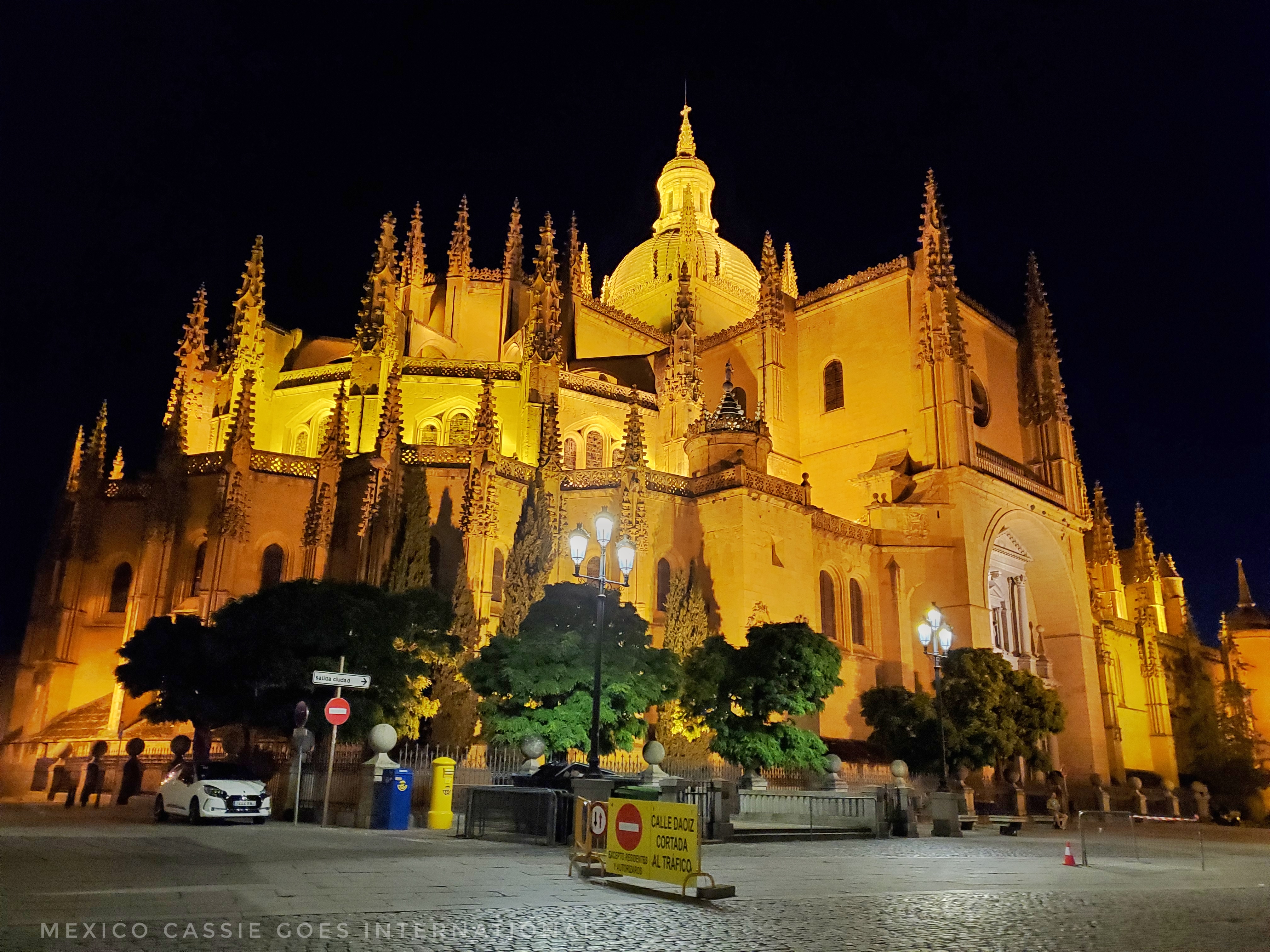
While the Plaza Mayor is absolutely a beautiful place to sit and while away time, the restaurants here, of course, are expensive. I recommend walking around the plaza as you explore the city but don’t stop for snacks here. If you’re interested in the gothic-style cathedral then it’s well worth taking an hour to explore inside.
Segovia Cathedral
The full name of this cathedral is rather a mouthful: Catedral de Nuestra Señora de la Asunción and San Frutos.
Built atop the highest point in Segovia, this was the very last Gothic cathedral to be built in Europe. Work began on the cathedral in 1525 during the reign of Carlos V to replace the old cathedral that burned down in 1520. There is a small art gallery in the basement of the cathedral that’s worth a visit while you’re there. I’m not a church fan generally but this is, in my opinion, one of the more interesting cathedrals to visit.
✅ No need to buy cathedral tickets in advance (but if you want to skip lines, and take a tour that includes the bell tower it might be a good idea)
⏱ 60 minutes unless you’re super into churches
➕ Sundays sees a Gregorian chant at El Parral mass and on Thursdays there is a small market in the Plaza Mayor.
Casa de los Picos
This 15th-century building is covered in granite points and currently houses the city art school. The building originally belonged to the De la Hoz family. It is their coat of arms that is replicated with the granite points. You can’t go in but the facade is definitely worth a photo.
Fundacion Torreon de Lozoya

We stumbled upon this beauty by mistake but I’m so glad we did. Because we only found it late in the day we raced through the (extremely good-looking) art gallery up to the tower top for the view of the city of Segovia. These did not disappoint either. Just gorgeous.
In my opinion, if you’re going to make time for one extra site in Segovia make it the Torreon de Lozoya or the Museo Real de la Moneda as these are true hidden gems of Segovia.
Day trips from Segovia
Generally, people are taking day trips TO Segovia, not from Segovia but that doesn’t mean there aren’t some cool options:
Palacio Real & La Granja
Just a twenty minute drive from Segovia is the small town of San Idelfonso, home of a royal palace and absolutely incredible gardens, La Granja. The palace was built in the early 18th century and was a royal summer residence.
I have explored the magnificent gardens but haven’t checked out the palace because stately homes aren’t really my thing but I have it on good authority from those who do enjoy them that it is fantastic. If you have time don’t miss the Royal Glass Factory, nearby.
🚗 This is best reached with your own (rental) car as there aren’t tours leaving from Segovia.
→ Book tickets (includes audioguide in chosen language)
DYC Whisky Distillery
DYC is the best of Spanish whiskies and it’s produced just down the road from Segovia. You can take a 2 hour tour (in English or Spanish) of the distillery where you’ll learn about the whole whisky making process and even get to try some of the whiskies made on site.
Visit a Segovia winery
Take a short (1.5hrs) tour of one of the smallest wineries in Castilla y León in the village of Navas de Oro. Learn about the limited edition wines made here and then try them.
Hot air balloon ride over Segovia
Take a magical morning hot air balloon ride over Segovia, see the incredible aqueduct and Alcazar from above before enjoying brunch and a glass of cava.
→ Book your hot air balloon experience
What to eat in Segovia
🍽 Roast suckling pig, cochinillo asado, is the local delicacy of the region and yes, if you eat meat it’s probably worth trying. As I said above, a good and cheap way to try it is to buy the snack-sized portion sold in the Alcazar’s cafe.
Our experience With Cochinillo
We decided that we wanted to try this delicacy so I did my research, found a restaurant with better reviews than others (many reviews on Google highlight what I’m about to tell you) and went with empty tummies and not a small measure of excitement.
It was… fine. But honestly, we found it to be extremely expensive. Service was definitely aimed at tourists (i.e. “we don’t care because you’re never coming back”) and the expensive pig came with nary a garnish. So, yes, try it if you’re super into trying local delicacies but don’t expect it to rock your world.
🍽 We had excellent meals at La Almuzara (vegetarian and extremely friendly) and Restaurante Pasapán. Both highly recommended.
🍽 If you’re looking for quick snacks while walking around, we all enjoyed pastries from Limon y Menta.
🍔 If you’re wondering why you don’t see any fast food restaurants in the Old City, it’s because they’re all huddled together on the other side of the Aqueduct.
If you enjoy Spanish adventures have you considered:
Mérida – perfect for Roman ruins
Seville – not just a gorgeous city but a great base for so many day trips and adventures
Cordoba – the mesquita is only the tip of this incredible city
Cadiz and its environs
Aracena – castles and wild mushrooms
Antequera for walks and ancient history
Almería – a small beach city in the south of Spain with oodles of charm and history
Toledo – is another city that’s also a popular day trip from Madrid
Valencia – a Mediterranean city bursting with museums, culture, and of course, paella
San Sebastian – a gorgeous Basque city known for its culture, incredible food and gorgeous nature

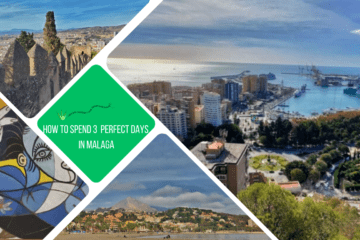
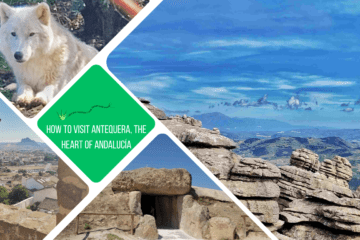
0 Comments